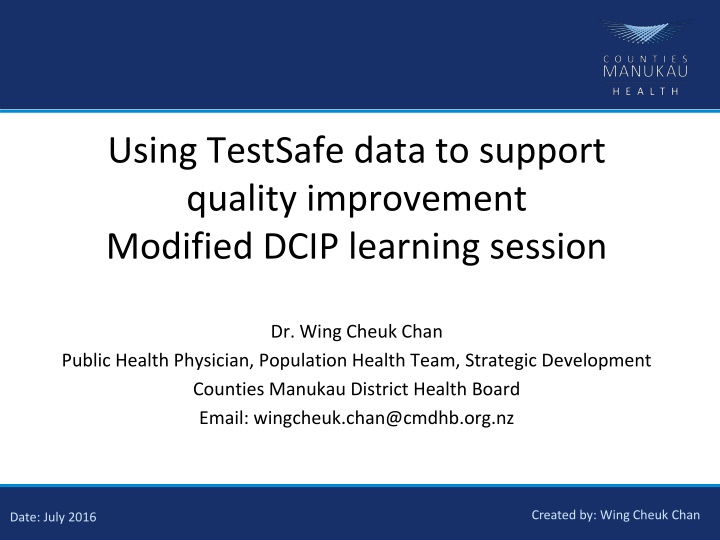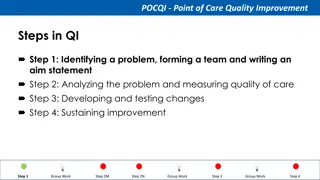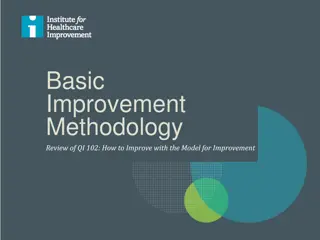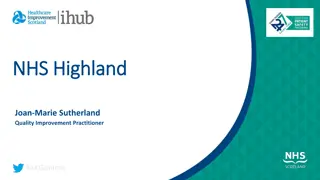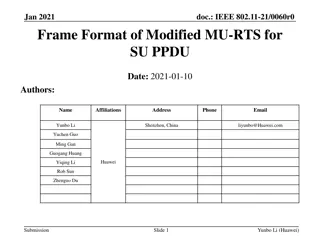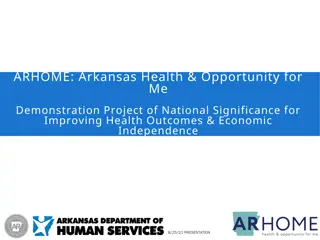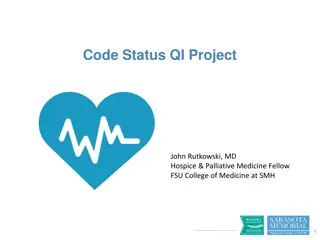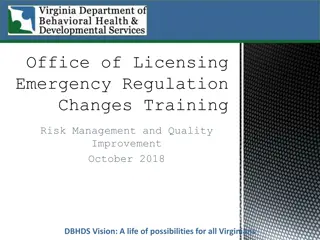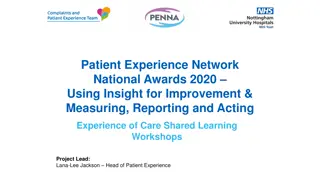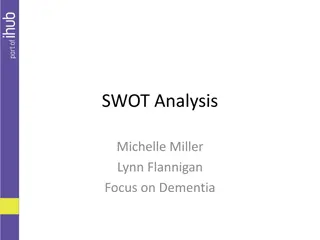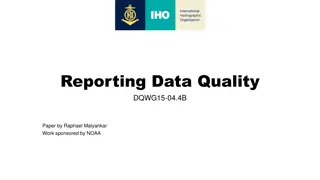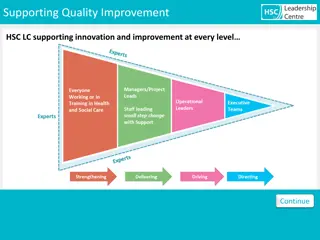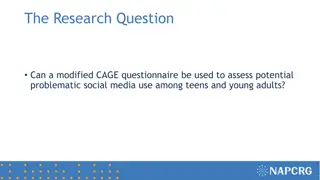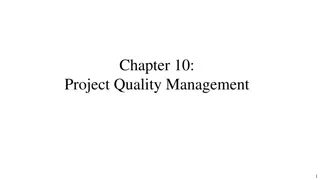Using TestSafe data to support quality improvement Modified DCIP learning session
This session with Dr. Wing Cheuk Chan focuses on leveraging TestSafe data for quality improvement in the Modified DCIP learning program. Dr. Chan, a public health physician from the Population Health Team at Counties Manukau District Health Board, will share insights and strategies to enhance the effectiveness of the program through data-driven approaches.
Download Presentation

Please find below an Image/Link to download the presentation.
The content on the website is provided AS IS for your information and personal use only. It may not be sold, licensed, or shared on other websites without obtaining consent from the author.If you encounter any issues during the download, it is possible that the publisher has removed the file from their server.
You are allowed to download the files provided on this website for personal or commercial use, subject to the condition that they are used lawfully. All files are the property of their respective owners.
The content on the website is provided AS IS for your information and personal use only. It may not be sold, licensed, or shared on other websites without obtaining consent from the author.
E N D
Presentation Transcript
Using TestSafe data to support quality improvement Modified DCIP learning session Dr. Wing Cheuk Chan Public Health Physician, Population Health Team, Strategic Development Counties Manukau District Health Board Email: wingcheuk.chan@cmdhb.org.nz Created by: Wing Cheuk Chan Date: July 2016
Overview of presentation Brief introduction about TestSafe and related publications Population level analyses to provide context Practice level analyses to be discussed as part of the learning session
TestSafe TestSafe is a regional lab results repository The lab results that you see in web clair / GP Concerto Contains all community and hospital lab test results in Auckland region in New Zealand since July 2006, not only the ones requested or carbon copy to the practice. Prior to July 2006, only hospital test results and community results that were sent to secondary care clinicians were recorded in the data repository
Results previously published Chan WC, Jackson G, Wright CS, et al. BMJ Open 2014;4:e003975. doi:10.1136/bmjopen-2013-003975 Major updates with significant methodological improvements are in progress using 2015 data
Linking clinical indications to pharmaceutical dispensing data from MOH
Prescribing and dispensing is highly correlated South Auckland study found 93% of the long term condition meds were subsequently dispensed within 7 days.
Diabetes related testing coverage is high in 2014 (Auckland metro, PHO enrolled population) % of people who had 2 or more fasting glucose, HbA1c and/or GTT, tests in Auckland region only Female 6% 30% 41% 49% 57% 66% 75% 82% 86% 90% 92% 93% 93% 88% 45% % of people who had at least one test in any of 4 test category Number of enrolled population Age Female 256,844 55,508 57,108 52,953 56,756 55,303 52,925 44,746 37,768 31,705 23,000 16,904 11,951 13,406 766,877 Male 261,107 47,409 47,848 45,589 49,813 50,790 49,642 42,104 35,630 30,413 21,221 14,659 9,427 7,448 713,100 Male 3% 16% 24% 38% 51% 65% 75% 82% 88% 91% 93% 94% 93% 91% 40% Female 33% 73% 79% 83% 87% 91% 94% 96% 97% 98% 98% 98% 99% 99% 70% Male 31% 60% 64% 74% 83% 90% 94% 96% 97% 98% 98% 98% 99% 99% 65% 0-24 25-29 30-34 35-39 40-44 45-49 50-54 55-59 60-64 65-69 70-74 75-79 80-84 85+ Overall Diabetes testing coverage is high among people eligible for CVD risk assessment
Definition of diabetes as per NZSSD guidelines Because actual test results are available in TestSafe Criteria: 2x Fasting glucose 7.0 mmol/L on different days 2x HbA1c 50 mmol/mol (6.7%) on different days (Note: International definition HbA1c 47.5 mmol/mol (6.5%) 2x Random glucose 11.1 mmol/L on different days 1x Glucose Tolerance test >= 11.1 mmol/L Or any of the combo: 1x HbA1c 50 mmol/mol +1x Fasting glucose 7.0 mmol/L on different days 1x HbA1c 50 mmol/mol +1x random glucose 11.1 mmol/L on different days 1x Fasting glucose 7.0 mmol/L + 1x Random glucose 11.1 mmol/L diabetes on different days
Undiagnosed diabetes Historical claims of the proportion of diabetes that is undiagnosed are no longer valid given the high testing coverage. Emphasis needs to be on improving management not just about screening
Diabetes prevalence, by age and ethnicity
Diabetes prevalence, by NZ deprivation index Gradient highlights importance of environmental drivers
People with poor glucose control (HbA1c 74.9) by age in 2013
Proportion of people with diabetes who had poor glucose control in 2013 by ethnicity
Urinary albumin testing by ethnicity (one or more test)
Urinary albumin testing by age (two or more test)
Prevalence of albuminuria/proteinuria within the group of people with laboratory evidence of diabetes Denominator: number of people with laboratory evidence of diabetes within the health service utilisation population in 2013 Numerator: number of people with 2 or more positive tests of urinary albumin/protein in two different days
% of people with diabetes who had proteinuria in 2013
ACE inhibitor and AIIRB use in people with diabetes and albuminuria/ proteinuria in CMDHB
Chronic kidney failure classification GFR (mL/min/1.73 m2) GFR stages Terms G1 >90 Normal or high G2 60 to 89 Mildly decreased Mildly to moderately decreased G3a 45 to 59 Moderately to severely decreased G3b 30 to 44 G4 15 to 29 Severely decreased Kidney failure (add D if treated by dialysis) G5 <15
Estimated prevalence by eGFR status (within the subgroup of people without diabetes in 2013)
Estimated prevalence by eGFR status, (within the subgroup of people with diabetes in 2013)
Purpose of practice level data Describes the clinical context that we work in, Explores practice variations, sharing helpful practice tips or model of care between practices that are helpful for our population, Highlights specific clinical scenarios and where there may be opportunities for improvement, Not about making judgement on quality
Patients that we look after About 9,100 people with diabetes are enrolled in the 11 practices participating in the modified DCIP program. The proportion of people with diabetes that had poor glycaemic control ranges from 21% to 39% (average 31%). The proportion of people with diabetes, and had microalbuminuria ranges from 43% to 69% (average 61%) Burden of disease is different by practices
Local data from TestSafe Number of people with HbA1c 74.9mmol/mol between Oct14 to Sep 15 Number of people with diabetes with 2x positive urinary microalbumin Number of people with diabetes Practice name 1 879 343 616 2 2,321 732 1,389 3 1,117 300 637 4 669 143 291 5 370 102 233 6 1,014 375 656 7 361 110 247 8 239 72 140 9 643 186 443 10 1,045 335 640 11 447 150 274 Total 9,105 2,848 5,566
A degree of renal impairment is common Within the modified DCIP practices, 20% of people with diabetes have eGFR <60mlmL/min/1.73 m2) , and 60% of people with diabetes do not have perfect kidney function Implications for medication use
Number of people by stages of eGFR G3a Mildly to moderately decreased G2 Mildly decreased G3b Moderately to severely decrease G4 Severely decreased Practice name G1 Normal or high G5 Kidney failure 1 245 399 125 61 29 27 2 1,034 867 229 106 47 50 3 364 519 114 65 24 30 4 274 271 71 31 15 9 5 161 140 41 14 6 10 6 347 444 113 61 29 24 7 129 148 43 17 11 13 8 115 76 23 14 6 8 9 212 274 85 39 20 17 10 473 374 99 47 31 25 11 198 160 52 13 10 16 3,552 3,672 995 468 228 229 Total
Do people with poor glycaemic control attend GP practices? Data via linkage to PHO enrolment Yes, but the nature of the appointment may not necessarily be related to diabetes though About 98% of people with HbA1c 74.9mmol/mol attended practice at least one in a year, and 83% had attended GP at least 3 quarters of the year. Potential for opportunistic proactive care, or arranged dedicated appointments
Proportion of people with poor diabetes control attended GP practice Practice Name Attended at least once in a year Attended at least 3 quarters of a year 97% 81% 1 99% 82% 2 97% 83% 3 99% 80% 4 99% 87% 5 97% 87% 6 98% 93% 7 100% 90% 8 100% 87% 9 98% 77% 10 100% 89% 11 Total 98% 83%
Of those people with high HbA1c 74.9mmol/mol .. 80% of them were in oral hypoglycaemia meds (in a 6 month period) 48% were on insulin (in a 6 month period) Only 10% were not on meds in the 6 month period. Dose titration of meds (and type of medications) may be a useful focus of future learning session. HbA1c from Oct 2014 to Sep 2015 (TestSafe), meds 2015 Sep to March 2016 from Pharmac Pharmhouse dispensing claims data
Use of meds for people with HbA1c 74.9 in a 6 month period Practice name Any meds Insulin Oral meds Metformin Acarbose Pioglitazone Sulfonylurea 1 89% 40% 81% 75% 29% 0.0% 50% 2 91% 46% 85% 83% 11% 0.1% 55% 3 92% 53% 81% 78% 15% 0.0% 59% 4 90% 52% 78% 73% 20% 0.7% 53% 5 94% 67% 79% 74% 4% 3.9% 44% 6 90% 51% 79% 75% 5% 2.1% 45% 7 89% 51% 77% 75% 5% 0.0% 46% 8 85% 58% 69% 67% 3% 1.4% 44% 9 90% 51% 79% 76% 13% 0.0% 59% 10 88% 48% 76% 72% 10% 1.2% 49% 11 88% 51% 78% 75% 12% 0.0% 53% 90% 49% 80% 77% 13% 0.7% 52% Total
What about treatment of microalbuminuria? About 5,560 people with diabetes with 2 more positive urinary microalbuminuria enrolled in the 11 modified DCIP practices. Overall 74% of them had received at least one script of Ace inhibitor or angiotensin II receptor blocker in a subsequent 6 months, but adherence appeared to fall over time and there were modest variations by practices.
What about treatment of microalbuminuria? Number of people with diabetes with 2x positive urinary micro albumin One or more script in 6 months (ACEi or ARIIB) 2 or more scripts in 6 months (ACEi or ARIIB) Practice name 1 616 72% 65% 2 1,389 76% 69% 3 637 76% 67% 4 291 76% 67% 5 233 67% 63% 6 656 72% 63% 7 247 72% 64% 8 140 76% 69% 9 443 76% 70% 10 640 72% 61% 11 274 68% 59% Total 5,566 74% 66%
In the subgroup with HbA1c 74.9mmol/mol and 2x positive microalbuminuria Higher proportions of people with HbA1c 74.9mmol/mol had microalbuminuria (75%) compared to the general diabetes group (61%) This group is at high risk for renal (and CVD) complications
In the subgroup with HbA1c 74.9mmol/mol and 2x positive microalbuminuria HbA1c 74.9 with 2x positive microalbuminuria One or more script in 6 months 2 or more scripts in 6 months Practice name 1 277 77% 71% 2 527 82% 74% 3 218 78% 69% 4 87 75% 64% 5 84 67% 62% 6 294 76% 68% 7 88 75% 64% 8 56 79% 71% 9 154 79% 71% 10 243 76% 57% 11 114 72% 59% Total 2,142 77% 68%
